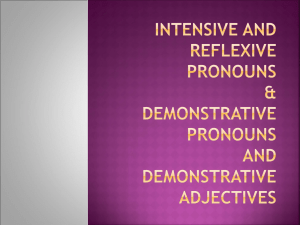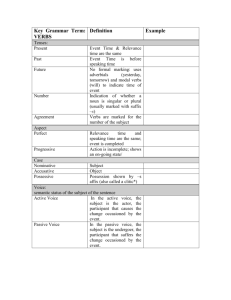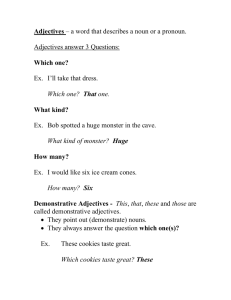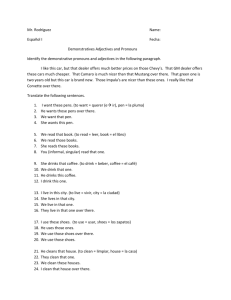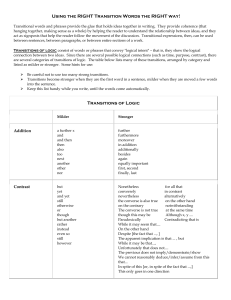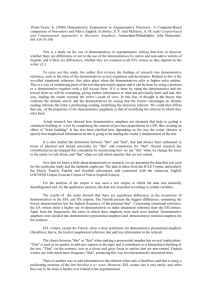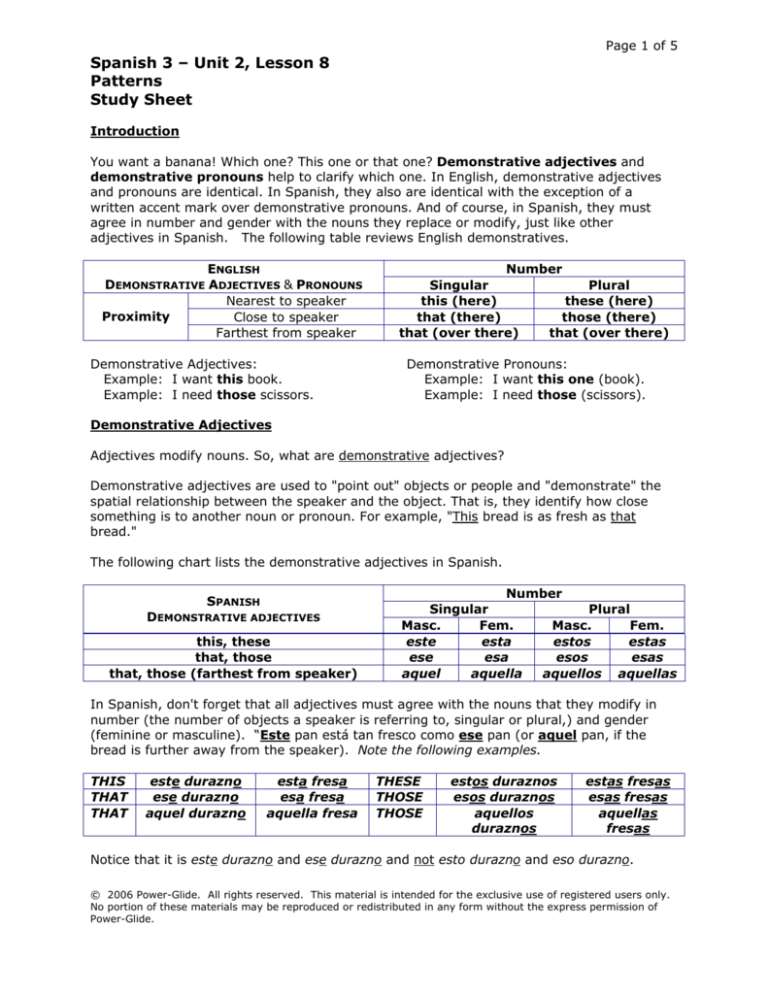
Page 1 of 5
Spanish 3 – Unit 2, Lesson 8
Patterns
Study Sheet
Introduction
You want a banana! Which one? This one or that one? Demonstrative adjectives and
demonstrative pronouns help to clarify which one. In English, demonstrative adjectives
and pronouns are identical. In Spanish, they also are identical with the exception of a
written accent mark over demonstrative pronouns. And of course, in Spanish, they must
agree in number and gender with the nouns they replace or modify, just like other
adjectives in Spanish. The following table reviews English demonstratives.
ENGLISH
DEMONSTRATIVE ADJECTIVES & PRONOUNS
Nearest to speaker
Proximity
Close to speaker
Farthest from speaker
Demonstrative Adjectives:
Example: I want this book.
Example: I need those scissors.
Number
Singular
Plural
this (here)
these (here)
that (there)
those (there)
that (over there)
that (over there)
Demonstrative Pronouns:
Example: I want this one (book).
Example: I need those (scissors).
Demonstrative Adjectives
Adjectives modify nouns. So, what are demonstrative adjectives?
Demonstrative adjectives are used to "point out" objects or people and "demonstrate" the
spatial relationship between the speaker and the object. That is, they identify how close
something is to another noun or pronoun. For example, "This bread is as fresh as that
bread."
The following chart lists the demonstrative adjectives in Spanish.
SPANISH
DEMONSTRATIVE ADJECTIVES
this, these
that, those
that, those (farthest from speaker)
Number
Singular
Plural
Masc.
Fem.
Masc.
Fem.
este
esta
estos
estas
ese
esa
esos
esas
aquel
aquella
aquellos aquellas
In Spanish, don't forget that all adjectives must agree with the nouns that they modify in
number (the number of objects a speaker is referring to, singular or plural,) and gender
(feminine or masculine). “Este pan está tan fresco como ese pan (or aquel pan, if the
bread is further away from the speaker). Note the following examples.
THIS
THAT
THAT
este durazno
ese durazno
aquel durazno
esta fresa
esa fresa
aquella fresa
THESE
THOSE
THOSE
estos duraznos
esos duraznos
aquellos
duraznos
estas fresas
esas fresas
aquellas
fresas
Notice that it is este durazno and ese durazno and not esto durazno and eso durazno.
© 2006 Power-Glide. All rights reserved. This material is intended for the exclusive use of registered users only.
No portion of these materials may be reproduced or redistributed in any form without the express permission of
Power-Glide.
Page 2 of 5
Spanish 3 – Unit 2, Lesson 8
Patterns
Study Sheet
Demonstrative Adjective Practice Exercise: Translate the word in quotes. Make sure it
agrees with the noun.
1.
“this” casa
2.
“these” fresas
3.
“this” teléfono
3.
“that” libro
4.
“those” hombres
5.
“that” chica
6.
“those” chicos
7.
“those” manzanas (over there, or far away)
8.
“that” señor (over there, or far away)
Now, scroll down and check your answers.
1.
2.
3.
4.
5.
6.
7.
8.
esta casa – notice that esta is feminine because casa is feminine
estas fresas – notice that estas is feminine and plural
este teléfono – notice that the masculine singular form ends in a “e” not “o”
ese libro – ese means that, still close to the speaker
esa chica – esa ends in an “a” because chica is feminine
esos chicos – notice that the noun is masculine and plural
aquellas manzanas – feminine & plural, the apples are farther from the speaker
aquel señor – the man is far from the speaker
Demonstrative Pronouns
Pronouns take the place of nouns. So, what are demonstrative pronouns?
Demonstrative pronouns look just like demonstrative adjectives except that they have a
written accent mark on the first é. The accent replaces the noun.
—Yo quiero aquella pera grande.
—¿Cuál? ¿Ésta?
—No. Ésa. La verde a la izquierda.
I want that big pear.
Which one? This one?
No. That one. The green one on the left.
In the brief dialogue above between a customer and a produce merchant, the accent over
ésta and ésa replaced the word pera. There was no need to repeat “pera” because both
speakers knew what item they were talking about. Notice that in English we typically use
the word “one” instead of an accent mark.
SPANISH
DEMONSTRATIVE PRONOUNS
THIS (one), THESE (ones)
THAT (one), THOSE (ones)
THAT (one) over there,
THOSE (ones) over there
Number
Singular
Plural
Masc.
Fem.
Masc.
Fem.
éste
ésta
éstos
éstas
ése
ésa
ésos
ésas
áquél
aquélla
aquéllos aquéllas
© 2006 Power-Glide. All rights reserved. This material is intended for the exclusive use of registered users only.
No portion of these materials may be reproduced or redistributed in any form without the express permission of
Power-Glide.
Page 3 of 5
Spanish 3 – Unit 2, Lesson 8
Patterns
Study Sheet
You should note that you CANNOT use a demonstrative pronoun without having previously
named the noun that it is replacing or unless it is clear in the context. Otherwise, no one
will understand what object you are referring to.
Demonstrative Pronoun Practice Exercise: Answer with the appropriate pronoun.
1.
2.
3.
4.
--¿Quiere Ud. comprar esta falda?
--¿Te gustan esos zapatos?
--Prefieres este abrigo o ése?
--¿Qué tienda te gusta más?
--No, gracias. Prefiero “that one.”
--Sí, me gustan “those.”
--Prefiero “this one.”
--“This one,” la joyería, por supuesto.
Now, scroll down and check your answers.
1.
2.
3.
4.
ésa – that one, The accent replaces falda.
ésos -- those, the accent replaces zapatos.
éste – this one, the accent replaces abrigo.
ésta – tienda is the understood noun so “this one” should be feminine.
NEUTER -- Each demonstrative pronoun also has a neuter or neutral form. It is used to
refer to abstract ideas, a previously mentioned statement, or something vague like an
unknown or unidentified object. The neuter pronouns do not change for number or gender,
and they do not have a written accent.
esto
eso
aquello
(this idea, this thing)
(that idea, that thing)
(that idea/thing over there)
¡Esto es importante!
¿Qué es eso?
This generic idea or concept is important!
What is that? -- the object is unknown
Using Demonstrative Pronouns and Demonstrative Adjectives Together
Demonstrative pronouns and demonstrative adjectives can be used together in the same
sentence. All you have to remember is that they must agree in person, number, and gender
with the noun(s) they replace or modify, and that in order to use a demonstrative pronoun,
you must have previously mentioned the noun that you are replacing. For example:
Estas ciruelas son grandes; ésas son pequeñas.
(These plums is large; that one there is small.)
and
Aquella fruta es amarga, pero ésta es dulce.
(That fruit over there is bitter, but this is sweet.)
© 2006 Power-Glide. All rights reserved. This material is intended for the exclusive use of registered users only.
No portion of these materials may be reproduced or redistributed in any form without the express permission of
Power-Glide.
Page 4 of 5
Spanish 3 – Unit 2, Lesson 8
Patterns
Study Sheet
Practice Exercises
To check your understanding of demonstrative pronouns and demonstrative adjectives,
complete the following exercises.
A. Sentence Completion: Demonstrative Adjectives
Write the appropriate form of the demonstrative pronoun in the space provided. The
masculine singular form of the demonstrative is provided in parentheses. Pay careful
attention to the gender and number of the noun it replaces.
1. __________
2. __________
3. __________
4. __________
5. __________
6. __________
7. __________
8. __________
9. __________
10. __________
11. __________
12. __________
13. __________
14. __________
15. __________
(Este) casa es hermosa.
(Ese) bolígrafo escribe bien.
(Aquel) libro contiene gramática española.
(Este) tienda es de mi tío.
(Ese) calles son estrechas (narrow).
(Aquel) soldado es valiente.
(Ese) mujer es inglesa.
(Este) hombres son corteses.
(Aquel) chico es portugués.
(Ese) flores son raras.
(Este) camisa es largísima.
(Aquel) carnicería vende la mejor carne.
(Este) reloj es un Rolex.
(Aquel) computadora no funciona bien.
(Ese) programas son buenos. *remember the rule for words ending in -ama
B. Sentence Completion: Demonstrative Pronouns
Circle the appropriate demonstrative pronoun in the parenthesis. Pay careful attention to
the noun it replaces.
1.
2.
3.
4.
5.
Prefiero la corbata roja, no (ése, ésa, esa) que está allí.
Me gusta aquella casa blanca, pero (éste, ésta, éstas) amarilla, no tanto.
Esas manzanas ahí están deliciosas, pero (éste, éstas, éstos) no están tan buenas.
Me gusta aquel automóvil pero (ése, ésa, ésos) que está allí es padrísimo (super cool).
Este chaleco es chévere (cool) pero (aquel, aquél, aquélla) que lleva el señor allá es
feo.
6. Las montañas detrás de la universidad son bonitas pero (aquél, aquéllas, aquéllos)
son desoladas.
7. Prefiero las fresas del estado de Oregón no (ésas, ésa, ése) de California.
8. El equipo vestido de azul es más talentoso que (éste, ésta, este) en rojo.
9. Aquellos cuadros de Picasso me caen mucho mejor que (este, éstas, éstos) de Dalí.
10. Preferimos las uvas verdes, no (éstas, ésta, éstos) moradas.
11. La ropa hecha en Honduras es más barata que (aquél, aquélla, aquéllas) hecha en
Nueva York.
12. Las zanahorias del supermercado son mejores que (éstos, éstas, éste).
© 2006 Power-Glide. All rights reserved. This material is intended for the exclusive use of registered users only.
No portion of these materials may be reproduced or redistributed in any form without the express permission of
Power-Glide.
Page 5 of 5
Spanish 3 – Unit 2, Lesson 8
Patterns
Study Sheet
C. Phrase Translation: Demonstrative Pronouns and Demonstrative Adjectives
Translate each of the following phrases. Do not translate the words that are in parenthesis –
they are only there to help you identify the distance from the speaker. Make sure to add an
accent to the demonstrative pronoun or the noun with the demonstrative adjective.
1.
2.
3.
4.
5.
6.
7.
8.
9.
10.
11.
12.
13.
14.
15.
those flowers (nearby)
that drugstore (nearby)
this (apricot right here)
those (shoes way over there)
these books (right here)
those clothes (nearby)
these apples (right here)
this map of Spain (right here)
those rivers (way over there)
that (bread nearby)
these (foods right here)
that (backpack way over there)
these (trees right here)
this year
that thing (nearby)
D. Translation
Translate each of the following phrases.
Example: I prefer this tie not that one (nearby).
Prefiero esta corbata, no ésa.
1.
I need this price, not that one.
2.
That class (over there) is bigger than
this one.
I like this watch, not that one (nearby).
3.
4.
5.
6.
Those shoes (over there) are more
expensive than these.
That is difficult. (unspecified idea)
7.
These exercises are easier than those.
8.
What is this? (unidentified object)
E. Writing Exercise
Write a dialogue in the store of your choice using at least six sentences. You and a friend
are deciding between two or three different objects. Be sure to use words like this, these,
that, those, and those over there.
© 2006 Power-Glide. All rights reserved. This material is intended for the exclusive use of registered users only.
No portion of these materials may be reproduced or redistributed in any form without the express permission of
Power-Glide.

